Reliability of Lower-Cost Sensors in the Analysis of Indoor Air Quality on Board Ships
Abstract
:1. Introduction
2. Materials and Methods
2.1. Lower-Cost Monitoring Device
2.2. Measuring Campaigns
2.3. Performance Assessment of Sensors
3. Results

4. Discussion and Conclusions
Author Contributions
Funding
Institutional Review Board Statement
Informed Consent Statement
Data Availability Statement
Acknowledgments
Conflicts of Interest
References
- Schieweck, A.; Salthammer, T. Emissions from Construction and Decoration Materials for Museum Showcases. Stud. Conserv. 2009, 54, 218–235. [Google Scholar] [CrossRef]
- Schieweck, A. Very Volatile Organic Compounds (VVOC) as Emissions from Wooden Materials and in Indoor Air of New Prefabricated Wooden Houses. Build. Environ. 2021, 190, 107537. [Google Scholar] [CrossRef]
- Zhao, Z.; Pei, Y.; Zhao, P.; Wu, C.; Qu, C.; Li, W.; Zhao, Y.; Liu, J. Characterizing Key Volatile Pollutants Emitted from Adhesives by Chemical Compositions, Odor Contributions and Health Risks. Molecules 2022, 27, 1125. [Google Scholar] [CrossRef] [PubMed]
- Tham, K.W. Indoor Air Quality and Its Effects on Humans—A Review of Challenges and Developments in the Last 30 Years. Energy Build. 2016, 130, 637–650. [Google Scholar] [CrossRef]
- Mannan, M.; Al-Ghamdi, S.G. Indoor Air Quality in Buildings: A Comprehensive Review on the Factors Influencing Air Pollution in Residential and Commercial Structure. Int. J. Environ. Res. Public. Health 2021, 18, 3276. [Google Scholar] [CrossRef]
- Saini, J.; Dutta, M.; Marques, G. A Comprehensive Review on Indoor Air Quality Monitoring Systems for Enhanced Public Health. Sustain. Environ. Res. 2020, 30, 6. [Google Scholar] [CrossRef]
- González-Martín, J.; Kraakman, N.J.R.; Pérez, C.; Lebrero, R.; Muñoz, R. A State–of–the-Art Review on Indoor Air Pollution and Strategies for Indoor Air Pollution Control. Chemosphere 2021, 262, 128376. [Google Scholar] [CrossRef]
- Farmer, D.K.; Vance, M.E.; Abbatt, J.P.D.; Abeleira, A.; Alves, M.R.; Arata, C.; Boedicker, E.; Bourne, S.; Cardoso-Saldaña, F.; Corsi, R.; et al. Overview of HOMEChem: House Observations of Microbial and Environmental Chemistry. Environ. Sci. Process. Impacts 2019, 21, 1280–1300. [Google Scholar] [CrossRef]
- Vardoulakis, S.; Giagloglou, E.; Steinle, S.; Davis, A.; Sleeuwenhoek, A.; Galea, K.S.; Dixon, K.; Crawford, J.O. Indoor Exposure to Selected Air Pollutants in the Home Environment: A Systematic Review. Int. J. Environ. Res. Public. Health 2020, 17, 8972. [Google Scholar] [CrossRef]
- Lee, K.K.; Bing, R.; Kiang, J.; Bashir, S.; Spath, N.; Stelzle, D.; Mortimer, K.; Bularga, A.; Doudesis, D.; Joshi, S.S.; et al. Adverse Health Effects Associated with Household Air Pollution: A Systematic Review, Meta-Analysis, and Burden Estimation Study. Lancet Glob. Health 2020, 8, e1427–e1434. [Google Scholar] [CrossRef]
- Stafoggia, M.; Oftedal, B.; Chen, J.; Rodopoulou, S.; Renzi, M.; Atkinson, R.W.; Bauwelinck, M.; Klompmaker, J.O.; Mehta, A.; Vienneau, D.; et al. Long-Term Exposure to Low Ambient Air Pollution Concentrations and Mortality among 28 Million People: Results from Seven Large European Cohorts within the ELAPSE Project. Lancet Planet. Health 2022, 6, e9–e18. [Google Scholar] [CrossRef]
- Barnes, N.; Ng, T.; Ma, K.; Lai, K. In-Cabin Air Quality during Driving and Engine Idling in Air-Conditioned Private Vehicles in Hong Kong. Int. J. Environ. Res. Public. Health 2018, 15, 611. [Google Scholar] [CrossRef] [PubMed]
- Tolis, E.I.; Karanotas, T.; Svolakis, G.; Panaras, G.; Bartzis, J.G. Air Quality into Cabin Environment of Different Passenger Cars: Effect of Car Usage, Fuel Type and Ventilation/Infiltration Conditions. Environ. Sci. Pollut. Res. 2021, 28, 51232–51241. [Google Scholar] [CrossRef] [PubMed]
- Xu, B.; Chen, X.; Xiong, J. Air Quality inside Motor Vehicles’ Cabins: A Review. Indoor Built Environ. 2018, 27, 452–465. [Google Scholar] [CrossRef]
- Cheng, X.; Tan, Z.; Wang, X.; Tay, R. Air Quality in a Commercial Truck Cabin. Transp. Res. Part Transp. Environ. 2006, 11, 389–395. [Google Scholar] [CrossRef]
- Dechow, M.; Nurcombe, C.A.H. Aircraft Environmental Control Systems. In Air Quality in Airplane Cabins and Similar Enclosed Spaces; Hocking, M., Ed.; The Handbook of Environmental Chemistry; Springer: Berlin/Heidelberg, Germany, 2005; Volume 4H, pp. 3–24. ISBN 978-3-540-25019-7. [Google Scholar]
- Golui, K.D. Air Quality in Airplane Cabins and Similar Enclosed Spaces. Available online: https://www.researchgate.net/publication/338528470_Air_Quality_in_Airplane_Cabins_and_Similar_Enclosed_Spaces (accessed on 23 September 2022).
- Hocking, M.B.; Hocking, D. Air Quality in Airplane Cabins and Similar Enclosed Spaces; Springer Science & Business Media: Berlin/Heidelberg, Germany, 2005; ISBN 978-3-540-25019-7. [Google Scholar]
- Kim, S.S.; Lee, Y.G. Field Measurements of Indoor Air Pollutant Concentrations on Two New Ships. Build. Environ. 2010, 45, 2141–2147. [Google Scholar] [CrossRef]
- Webster, A.D.; Reynolds, G.L. Indoor Air Quality on Passenger Ships. In Air Quality in Airplane Cabins and Similar Enclosed Spaces; Hocking, M., Ed.; The Handbook of Environmental Chemistry; Springer: Berlin/Heidelberg, Germany, 2005; Volume 4H, pp. 335–349. ISBN 978-3-540-25019-7. [Google Scholar]
- Strandberg, B.; Österman, C.; Koca Akdeva, H.; Moldanová, J.; Langer, S. The Use of Polyurethane Foam (PUF) Passive Air Samplers in Exposure Studies to PAHs in Swedish Seafarers. Polycycl. Aromat. Compd. 2022, 42, 448–459. [Google Scholar] [CrossRef]
- Langer, S.; Österman, C.; Strandberg, B.; Moldanová, J.; Fridén, H. Impacts of Fuel Quality on Indoor Environment Onboard a Ship: From Policy to Practice. Transp. Res. Part Transp. Environ. 2020, 83, 102352. [Google Scholar] [CrossRef]
- Langer, S.; Moldanová, J.; Österman, C. Influence of Fuel Change on Indoor Environmental Quality On-Board a Passenger Ferry. In Proceedings of the 14th International Conference of Indoor Air Quality and Climate, Ghent, Belgium, 4–8 July 2016; p. 9. [Google Scholar]
- Langer, S.; Moldanová, J.; Bloom, E.; Österman, C. Indoor Environment On-Board the Swedish Icebreaker Oden. In Proceedings of Indoor Air 2014; Indoor Air Technical Committee, Ed.; International Society for Indoor Air Quality and Climate (ISIAQ): Hong Kong, China, 2014; p. 8. [Google Scholar]
- Busch, D.; Krause, K. Air Quality on the Rhine and in the Inland Ports of Duisburg and Neuss. Immissionsschutz 2021, 26, 9. [Google Scholar] [CrossRef]
- Wang, X.; Shen, Y.; Lin, Y.; Pan, J.; Zhang, Y.; Louie, P.K.K.; Li, M.; Fu, Q. Atmospheric Pollution from Ships and Its Impact on Local Air Quality at a Port Site in Shanghai. Atmos. Chem. Phys. 2019, 19, 6315–6330. [Google Scholar] [CrossRef] [Green Version]
- Walker, T.R.; Adebambo, O.; Feijoo, M.C.D.A.; Elhaimer, E.; Hossain, T.; Edwards, S.J.; Morrison, C.E.; Romo, J.; Sharma, N.; Taylor, S.; et al. World Seas: An Environmental Evaluation Volume III: Ecological Issues and Environmental Impacts. In World Seas: An Environmental Evaluation; Academic Press: Cambridge, MA, USA, 2019; Volume 3, p. 26. [Google Scholar]
- Mueller, D.; Uibel, S.; Takemura, M.; Klingelhoefer, D.; Groneberg, D.A. Ships, Ports and Particulate Air Pollution—An Analysis of Recent Studies. J. Occup. Med. Toxicol. 2011, 6, 31. [Google Scholar] [CrossRef] [PubMed]
- IMO. Third IMO Greenhouse Gas Study 2014: Executive Summary and Final Report; International Maritime Organization: London, UK, 2015. [Google Scholar]
- Dabdub, D. Air Quality Impacts of Ship Emissions in the South Coast Air Basin of California; University of California: Irvine, CA, USA, 2008; p. 45. [Google Scholar]
- Zhao, J.; Wei, Q.; Wang, S.; Ren, X. Progress of Ship Exhaust Gas Control Technology. Sci. Total Environ. 2021, 799, 149437. [Google Scholar] [CrossRef] [PubMed]
- Lehtoranta, K.; Aakko-Saksa, P.; Murtonen, T.; Vesala, H.; Ntziachristos, L.; Rönkkö, T.; Karjalainen, P.; Kuittinen, N.; Timonen, H. Particulate Mass and Nonvolatile Particle Number Emissions from Marine Engines Using Low-Sulfur Fuels, Natural Gas, or Scrubbers. Environ. Sci. Technol. 2019, 53, 3315–3322. [Google Scholar] [CrossRef]
- Pillot, D.; Guiot, B.; Cottier, P.L.; Perret, P.; Tassel, P. Exhaust Emissions from In-Service Inland Waterways Vessels. In Proceedings of the TAP 2016, 21st International Transport and Air Pollution Conference, Lyon, France, 24–26 May 2016; Scienpress Ltd.: Lyon, France, 2016; Volume 6, pp. 205–225. [Google Scholar]
- Jacobs, W. Cargo Vapour Concentrations on Board Chemical Tankers in the Non-Cargo Area during Normal Operations. Ph.D. Thesis, Antwerp Maritime Academy, Antwerp, Belgium, 2019. [Google Scholar]
- Jacobs, W.; Reynaerts, C.; Andries, S.; Akker, S.; van den Moonen, N.; Lamoen, D. Analyzing the Dispersion of Cargo Vapors around a Ship’s Superstructure by Means of Wind Tunnel Experiments. J. Mar. Sci. Technol. 2016, 21, 758–766. [Google Scholar] [CrossRef]
- Celebi, U.B.; Vardar, N. Investigation of VOC Emissions from Indoor and Outdoor Painting Processes in Shipyards. Atmos. Environ. 2008, 42, 5685–5695. [Google Scholar] [CrossRef]
- Wang, X.; Guan, J.; Chattopadhyay, G.; Britton, G.; Panayotou, K.; Dickinson, T.; Stuetz, R.M. Odour and Odorant Emission Estimation of Dredged Sediment. In Proceedings of the A&WMA InternationaI Specialty Conference: Leapfrogging Opportunities for Air Quality Improvement, Xi’an, China, 10–14 May 2010; pp. 366–372. [Google Scholar]
- Wan, Y.; Ruan, X.; Wang, X.; Ma, Q.; Lu, X. Odour Emission Characteristics of 22 Recreational Rivers in Nanjing. Environ. Monit. Assess. 2014, 186, 6061–6081. [Google Scholar] [CrossRef] [PubMed]
- EU. Directive 2008/50/EC on Ambient Air Quality. Off. J. Eur. Union 2008, L152, 44. [Google Scholar]
- Morawska, L.; Thai, P.K.; Liu, X.; Asumadu-Sakyi, A.; Ayoko, G.; Bartonova, A.; Bedini, A.; Chai, F.; Christensen, B.; Dunbabin, M.; et al. Applications of Low-Cost Sensing Technologies for Air Quality Monitoring and Exposure Assessment: How Far Have They Gone? Environ. Int. 2018, 116, 286–299. [Google Scholar] [CrossRef]
- Snyder, E.G.; Watkins, T.H.; Solomon, P.A.; Thoma, E.D.; Williams, R.W.; Hagler, G.S.W.; Shelow, D.; Hindin, D.A.; Kilaru, V.J.; Preuss, P.W. The Changing Paradigm of Air Pollution Monitoring. Environ. Sci. Technol. 2013, 47, 11369–11377. [Google Scholar] [CrossRef]
- Fanti, G.; Spinazzè, A.; Borghi, F.; Rovelli, S.; Campagnolo, D.; Keller, M.; Borghi, A.; Cattaneo, A.; Cauda, E.; Cavallo, D.M. Evolution and Applications of Recent Sensing Technology for Occupational Risk Assessment: A Rapid Review of the Literature. Sensors 2022, 22, 4841. [Google Scholar] [CrossRef]
- Fanti, G.; Borghi, F.; Spinazzè, A.; Rovelli, S.; Campagnolo, D.; Keller, M.; Cattaneo, A.; Cauda, E.; Cavallo, D.M. Features and Practicability of the Next-Generation Sensors and Monitors for Exposure Assessment to Airborne Pollutants: A Systematic Review. Sensors 2021, 21, 4513. [Google Scholar] [CrossRef] [PubMed]
- Howard, J.; Murashov, V.; Cauda, E.; Snawder, J. Advanced Sensor Technologies and the Future of Work. Am. J. Ind. Med. 2022, 65, 3–11. [Google Scholar] [CrossRef]
- Ródenas García, M.; Spinazzé, A.; Branco, P.T.B.S.; Borghi, F.; Villena, G.; Cattaneo, A.; Di Gilio, A.; Mihucz, V.G.; Gómez Álvarez, E.; Lopes, S.I.; et al. Review of Low-Cost Sensors for Indoor Air Quality: Features and Applications. Appl. Spectrosc. Rev. 2022, 1–33. [Google Scholar] [CrossRef]
- Jo, J.; Jo, B.; Kim, J.; Kim, S.; Han, W. Development of an IoT-Based Indoor Air Quality Monitoring Platform. J. Sens. 2020, 2020, 8749764. [Google Scholar] [CrossRef]
- Suriano, D. A Portable Air Quality Monitoring Unit and a Modular, Flexible Tool for on-Field Evaluation and Calibration of Low-Cost Gas Sensors. HardwareX 2021, 9, e00198. [Google Scholar] [CrossRef] [PubMed]
- Hernández Rodríguez, E.; Schalm, O.; Martínez, A. Development of a Low-Cost Measuring System for the Monitoring of Environmental Parameters That Affect Air Quality for Human Health. ITEGAM-J. Eng. Technol. Ind. Appl. 2020, 6, 22–27. [Google Scholar] [CrossRef]
- Molka-Danielsen, J. Large Scale Integration of Wireless Sensor Network Technologies for Air Quality Monitoring at a Logistics Shipping Base. J. Ind. Inf. Integr. 2018, 9, 20–28. [Google Scholar] [CrossRef]
- Rodriguez-Vasquez, K.A.; Cole, A.M.; Yordanova, D.; Smith, R.; Kidwell, N.M. AIRduino: On-Demand Atmospheric Secondary Organic Aerosol Measurements with a Mobile Arduino Multisensor. J. Chem. Educ. 2020, 97, 838–844. [Google Scholar] [CrossRef]
- Alkandari, A.A.; Moein, S. Implementation of Monitoring System for Air Quality Using Raspberry PI: Experimental Study. Indones. J. Electr. Eng. Comput. Sci. 2018, 10, 43. [Google Scholar] [CrossRef]
- Gunawan, T.S.; Saiful Munir, Y.M.; Kartiwi, M.; Mansor, H. Design and Implementation of Portable Outdoor Air Quality Measurement System Using Arduino. Int. J. Electr. Comput. Eng. 2018, 8, 280. [Google Scholar] [CrossRef]
- Cross, E.S.; Williams, L.R.; Lewis, D.K.; Magoon, G.R.; Onasch, T.B.; Kaminsky, M.L.; Worsnop, D.R.; Jayne, J.T. Use of Electrochemical Sensors for Measurement of Air Pollution: Correcting Interference Response and Validating Measurements. Atmos. Meas. Tech. 2017, 10, 3575–3588. [Google Scholar] [CrossRef] [Green Version]
- Narayana, M.V.; Jalihal, D.; Nagendra, S.M.S. Establishing A Sustainable Low-Cost Air Quality Monitoring Setup: A Survey of the State-of-the-Art. Sensors 2022, 22, 394. [Google Scholar] [CrossRef] [PubMed]
- Abraham, S.; Li, X. A Cost-Effective Wireless Sensor Network System for Indoor Air Quality Monitoring Applications. Procedia Comput. Sci. 2014, 34, 165–171. [Google Scholar] [CrossRef]
- Panaitescu, M.; Panaitescu, F.V.; Dumitrescu, M.V.; Panaitescu, V.N. The Impact of Quality Air in The Engine Room on the Crew. TransNav Int. J. Mar. Navig. Saf. Sea Transp. 2019, 13, 409–414. [Google Scholar] [CrossRef]
- Samad, A.; Obando Nuñez, D.R.; Solis Castillo, G.C.; Laquai, B.; Vogt, U. Effect of Relative Humidity and Air Temperature on the Results Obtained from Low-Cost Gas Sensors for Ambient Air Quality Measurements. Sensors 2020, 20, 5175. [Google Scholar] [CrossRef]
- Wei, P.; Ning, Z.; Ye, S.; Sun, L.; Yang, F.; Wong, K.; Westerdahl, D.; Louie, P. Impact Analysis of Temperature and Humidity Conditions on Electrochemical Sensor Response in Ambient Air Quality Monitoring. Sensors 2018, 18, 59. [Google Scholar] [CrossRef]
- Wahlborg, D.; Björling, M.; Mattsson, M. Evaluation of Field Calibration Methods and Performance of AQMesh, a Low-Cost Air Quality Monitor. Environ. Monit. Assess. 2021, 193, 251. [Google Scholar] [CrossRef]
- Mijling, B.; Jiang, Q.; de Jonge, D.; Bocconi, S. Field Calibration of Electrochemical NO2 Sensors in a Citizen Science Context. Atmos. Meas. Tech. 2018, 11, 1297–1312. [Google Scholar] [CrossRef]
- Gonzalez, A.; Boies, A.; Swason, J.; Kittelson, D. Field Calibration of Low-Cost Air Pollution Sensors. Atmos. Meas. Tech. Discuss. 2019, 19, 1–7. [Google Scholar]
- Arroyo, P.; Gómez-Suárez, J.; Suárez, J.I.; Lozano, J. Low-Cost Air Quality Measurement System Based on Electrochemical and PM Sensors with Cloud Connection. Sensors 2021, 21, 6228. [Google Scholar] [CrossRef]
- Bigi, A.; Mueller, M.; Grange, S.K.; Ghermandi, G.; Hueglin, C. Performance of NO, NO2 Low Cost Sensors and Three Calibration Approaches within a Real World Application. Atmos. Meas. Tech. 2018, 11, 3717–3735. [Google Scholar] [CrossRef]
- Aguiar, E.F.K.; Roig, H.L.; Mancini, L.H.; Carvalho, E.N.C.B. de Low-Cost Sensors Calibration for Monitoring Air Quality in the Federal District—Brazil. J. Environ. Prot. 2015, 6, 173–189. [Google Scholar] [CrossRef] [Green Version]
- Ionascu, M.-E.; Castell, N.; Boncalo, O.; Schneider, P.; Darie, M.; Marcu, M. Calibration of CO, NO2, and O3 Using Airify: A Low-Cost Sensor Cluster for Air Quality Monitoring. Sensors 2021, 21, 7977. [Google Scholar] [CrossRef] [PubMed]
- Zimmerman, N.; Presto, A.A.; Kumar, S.P.N.; Gu, J.; Hauryliuk, A.; Robinson, E.S.; Robinson, A.L.; Subramanian, R. A Machine Learning Calibration Model Using Random Forests to Improve Sensor Performance for Lower-Cost Air Quality Monitoring. Atmos. Meas. Tech. 2018, 11, 291–313. [Google Scholar] [CrossRef]
- Smith, K.R.; Edwards, P.M.; Ivatt, P.D.; Lee, J.D.; Squires, F.; Dai, C.; Peltier, R.E.; Evans, M.J.; Sun, Y.; Lewis, A.C. An Improved Low-Power Measurement of Ambient NO2 and O3 Combining Electrochemical Sensor Clusters and Machine Learning. Atmos. Meas. Tech. 2019, 12, 1325–1336. [Google Scholar] [CrossRef]
- Wijeratne, L.O.H.; Kiv, D.R.; Aker, A.R.; Talebi, S.; Lary, D.J. Using Machine Learning for the Calibration of Airborne Particulate Sensors. Sensors 2019, 20, 99. [Google Scholar] [CrossRef]
- Drewnick, F.; Böttger, T.; von der Weiden-Reinmüller, S.-L.; Zorn, S.R.; Klimach, T.; Schneider, J.; Borrmann, S. Design of a Mobile Aerosol Research Laboratory and Data Processing Tools for Effective Stationary and Mobile Field Measurements. Atmos. Meas. Tech. 2012, 5, 1443–1457. [Google Scholar] [CrossRef]
- Borrego, C.; Costa, A.M.; Ginja, J.; Amorim, M.; Coutinho, M.; Karatzas, K.; Sioumis, T.; Katsifarakis, N.; Konstantinidis, K.; De Vito, S.; et al. Assessment of Air Quality Microsensors versus Reference Methods: The EuNetAir Joint Exercise. Atmos. Environ. 2016, 147, 246–263. [Google Scholar] [CrossRef]
- Beecken, J.; Mellqvist, J.; Salo, K.; Ekholm, J.; Jalkanen, J.-P. Airborne Emission Measurements of SO2, NOx and Particles from Individual Ships Using a Sniffer Technique. Atmos. Meas. Tech. 2014, 7, 1957–1968. [Google Scholar] [CrossRef]
- Anand, A.; Wei, P.; Gali, N.K.; Sun, L.; Yang, F.; Westerdahl, D.; Zhang, Q.; Deng, Z.; Wang, Y.; Liu, D.; et al. Protocol Development for Real-Time Ship Fuel Sulfur Content Determination Using Drone Based Plume Sniffing Microsensor System. Sci. Total Environ. 2020, 744, 140885. [Google Scholar] [CrossRef]
- Sagona, J.A.; Weisel, C.P.; Meng, Q. Accuracy and Practicality of a Portable Ozone Monitor for Personal Exposure Estimates. Atmos. Environ. 2018, 175, 120–126. [Google Scholar] [CrossRef]
- Lindqvist, F. A Differential Galvanic Atmospheric Ozone Monitor. Analyst 1972, 97, 549. [Google Scholar] [CrossRef] [PubMed]
- Concas, F.; Mineraud, J.; Lagerspetz, E.; Varjonen, S.; Liu, X.; Puolamäki, K.; Nurmi, P.; Tarkoma, S. Low-Cost Outdoor Air Quality Monitoring and Sensor Calibration: A Survey and Critical Analysis. ACM Trans. Sens. Netw. 2021, 17, 1–44. [Google Scholar] [CrossRef]
- Venkatraman Jagatha, J.; Klausnitzer, A.; Chacón-Mateos, M.; Laquai, B.; Nieuwkoop, E.; van der Mark, P.; Vogt, U.; Schneider, C. Calibration Method for Particulate Matter Low-Cost Sensors Used in Ambient Air Quality Monitoring and Research. Sensors 2021, 21, 3960. [Google Scholar] [CrossRef] [PubMed]
- Artinano, B.; Narros, A.; Diaz, E.; Gomez, F.J.; Borge, R. Low-Cost Sensors for Urban Air Quality Monitoring: Preliminary Laboratory and in-Field Tests within the TECNAIRE-CM Project. In Proceedings of the 2019 5th Experiment International Conference (exp.at’19), Funchal, Portugal, 12–14 June 2019; IEEE: Funchal, Portugal, 2019; pp. 462–466. [Google Scholar]
- Pearson, R.K.; Neuvo, Y.; Astola, J.; Gabbouj, M. Generalized Hampel Filters. EURASIP J. Adv. Signal Process. 2016, 2016, 87. [Google Scholar] [CrossRef]
- Kuittinen, N.; Jalkanen, J.-P.; Alanen, J.; Ntziachristos, L.; Hannuniemi, H.; Johansson, L.; Karjalainen, P.; Saukko, E.; Isotalo, M.; Aakko-Saksa, P.; et al. Shipping Remains a Globally Significant Source of Anthropogenic PN Emissions Even after 2020 Sulfur Regulation. Environ. Sci. Technol. 2021, 55, 129–138. [Google Scholar] [CrossRef] [PubMed]
- Lewis, A.C.; Lee, J.D.; Edwards, P.M.; Shaw, M.D.; Evans, M.J.; Moller, S.J.; Smith, K.R.; Buckley, J.W.; Ellis, M.; Gillot, S.R.; et al. Evaluating the Performance of Low Cost Chemical Sensors for Air Pollution Research. Faraday Discuss. 2016, 189, 85–103. [Google Scholar] [CrossRef]
- Li, H.; Zhu, Y.; Zhao, Y.; Chen, T.; Jiang, Y.; Shan, Y.; Liu, Y.; Mu, J.; Yin, X.; Wu, D.; et al. Evaluation of the Performance of Low-Cost Air Quality Sensors at a High Mountain Station with Complex Meteorological Conditions. Atmosphere 2020, 11, 212. [Google Scholar] [CrossRef]
- Kang, Y.; Aye, L.; Ngo, T.D.; Zhou, J. Performance Evaluation of Low-Cost Air Quality Sensors: A Review. Sci. Total Environ. 2022, 818, 151769. [Google Scholar] [CrossRef]
- Tagle, M.; Rojas, F.; Reyes, F.; Vásquez, Y.; Hallgren, F.; Lindén, J.; Kolev, D.; Watne, Å.K.; Oyola, P. Field Performance of a Low-Cost Sensor in the Monitoring of Particulate Matter in Santiago, Chile. Environ. Monit. Assess. 2020, 192, 171. [Google Scholar] [CrossRef]
- Schalm, O.; Cabal, A.; Anaf, W.; Leyva Pernia, D.; Callier, J.; Ortega, N. A Decision Support System for Preventive Conservation: From Measurements towards Decision Making. Eur. Phys. J. Plus 2019, 134, 74. [Google Scholar] [CrossRef]
- Anaf, W.; Leyva Pernia, D.; Schalm, O. Standardized Indoor Air Quality Assessments as a Tool to Prepare Heritage Guardians for Changing Preservation Conditions Due to Climate Change. Geosciences 2018, 8, 276. [Google Scholar] [CrossRef] [Green Version]
- Carro, G.; Schalm, O.; Jacobs, W.; Demeyer, S. Exploring Actionable Visualizations for Environmental Data: Air Quality Assessment of Two Belgian Locations. Environ. Model. Softw. 2022, 147, 105230. [Google Scholar] [CrossRef]
- Abdul-Wahab, S.A.; Chin Fah En, S.; Elkamel, A.; Ahmadi, L.; Yetilmezsoy, K. A Review of Standards and Guidelines Set by International Bodies for the Parameters of Indoor Air Quality. Atmos. Pollut. Res. 2015, 6, 751–767. [Google Scholar] [CrossRef]
- Nazarenko, Y.; Pal, D.; Ariya, P.A. Air Quality Standards for the Concentration of Particulate Matter 2.5, Global Descriptive Analysis. Bull. World Health Organ. 2021, 99, 125D–137D. [Google Scholar] [CrossRef]
- Leighton, P.A. Photochemistry of Air Pollution. In Physical Chemistry; Academic Press: New York, NY, USA, 1961; ISBN 978-0-12-442250-6. [Google Scholar]
- European Norm EN 14211:2012; Ambient Air—Standard Method for the Measurement of the Concentration of Nitrogen Dioxide and Nitrogen Monoxide by Chemiluminescence. European Committee for Standardization: Brussels, Belgium, 2012.
- European Norm EN 14625:2012; Ambient Air—Standard Method for the Measurement of the Concentration of Ozone by Ultraviolet Photometry. European Committee for Standardization: Brussels, Belgium, 2012.
- Vedachalam, S.; Baquerizo, N.; Dalai, A.K. Review on Impacts of Low Sulfur Regulations on Marine Fuels and Compliance Options. Fuel 2022, 310, 122243. [Google Scholar] [CrossRef]
- Belgian Interregional Environment Agency (IRCEL—CELINE—English. Available online: https://www.irceline.be/en/front-page?set_language=en (accessed on 18 May 2022).
- Alanen, J.; Isotalo, M.; Kuittinen, N.; Simonen, P.; Martikainen, S.; Kuuluvainen, H.; Honkanen, M.; Lehtoranta, K.; Nyyssönen, S.; Vesala, H.; et al. Physical Characteristics of Particle Emissions from a Medium Speed Ship Engine Fueled with Natural Gas and Low-Sulfur Liquid Fuels. Environ. Sci. Technol. 2020, 54, 5376–5384. [Google Scholar] [CrossRef]
- Bencs, L.; Horemans, B.; Buczyńska, A.J.; Deutsch, F.; Degraeuwe, B.; Van Poppel, M.; Van Grieken, R. Seasonality of Ship Emission Related Atmospheric Pollution over Coastal and Open Waters of the North Sea. Atmos. Environ. X 2020, 7, 100077. [Google Scholar] [CrossRef]
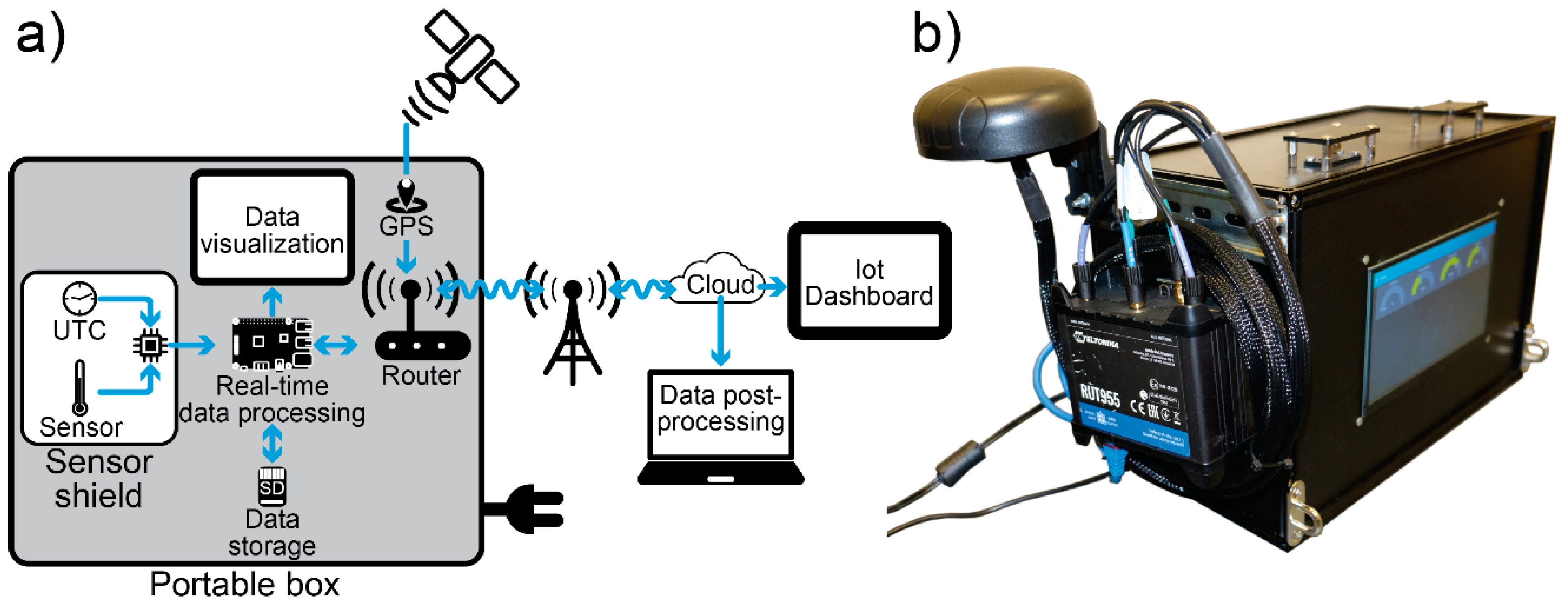
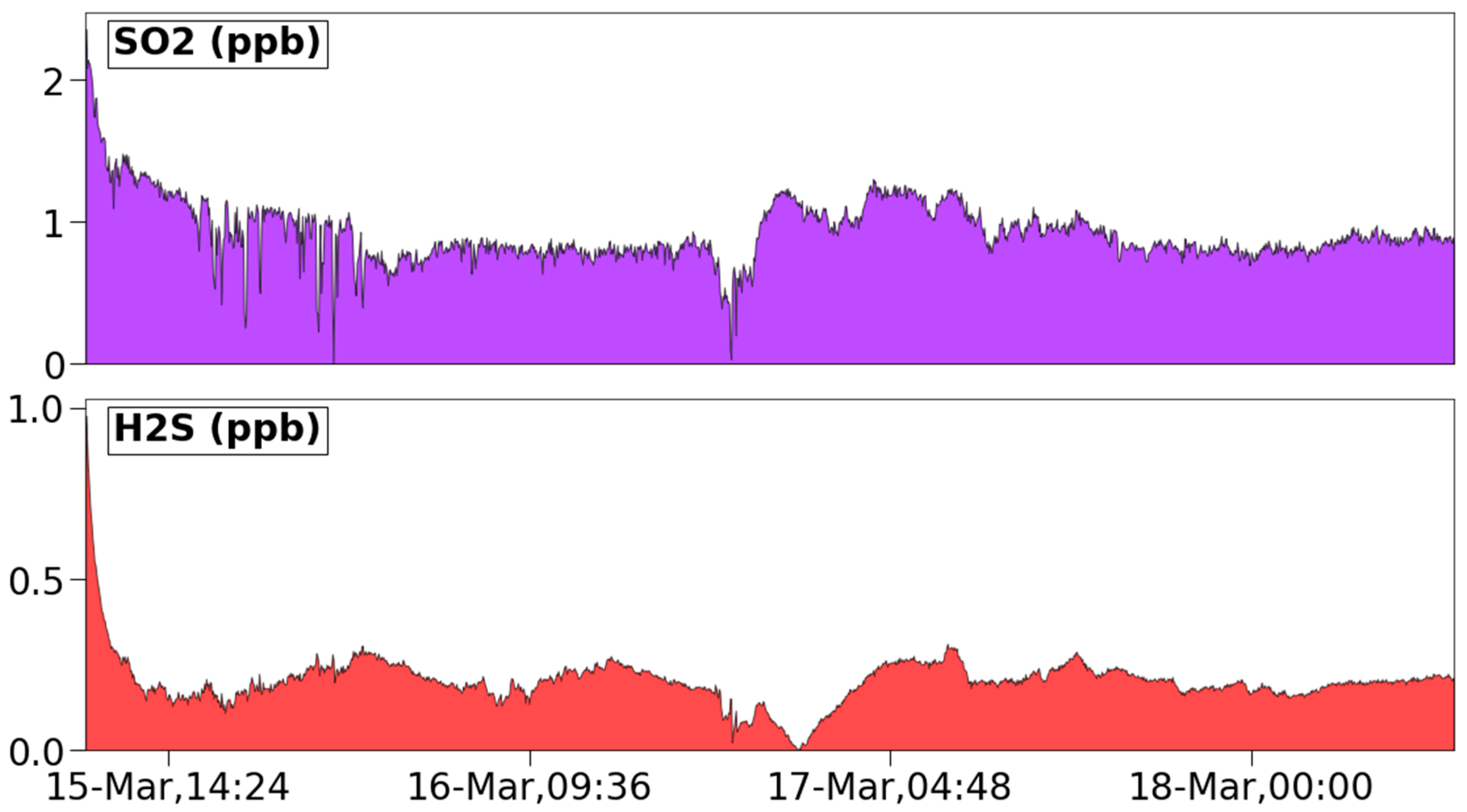
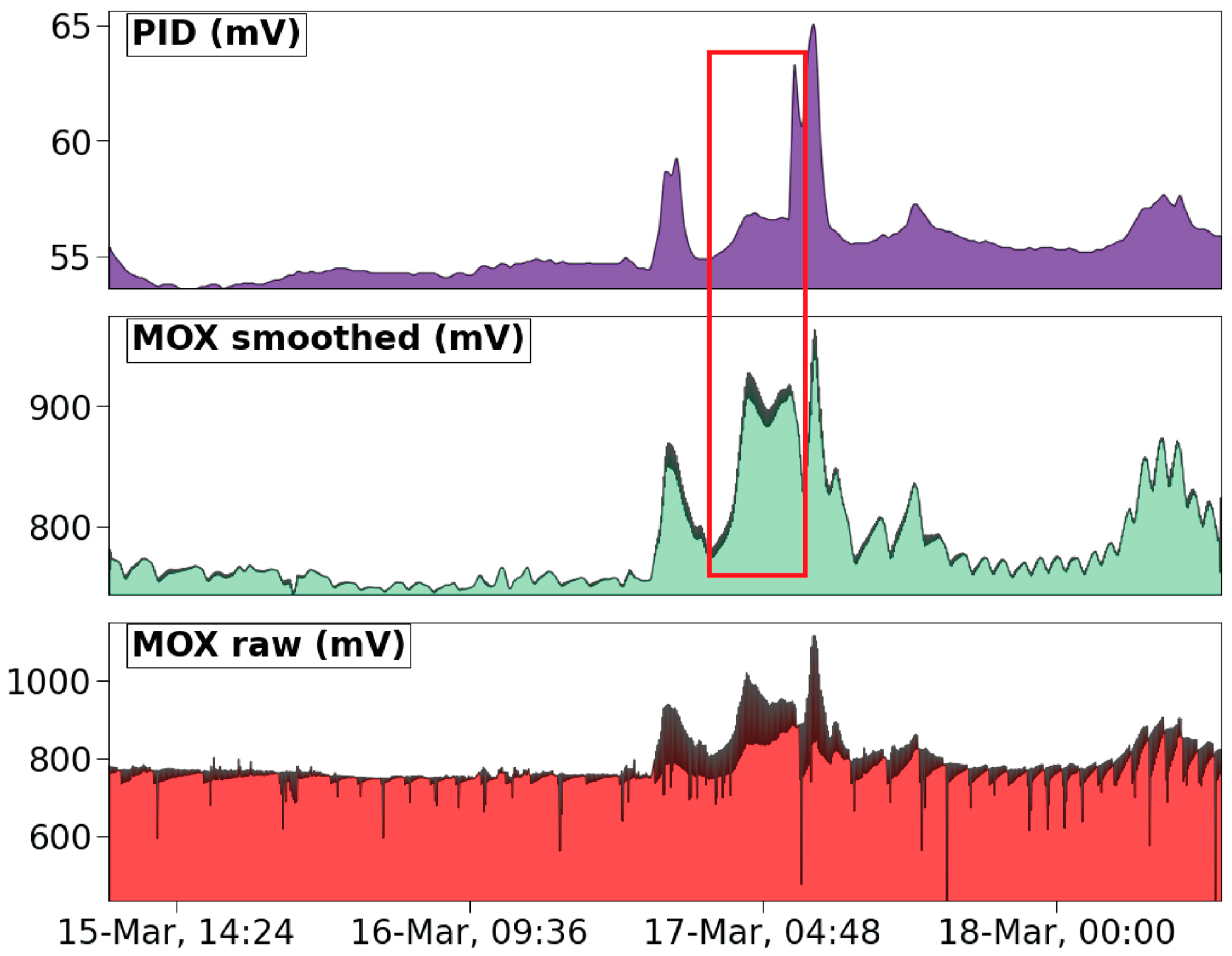
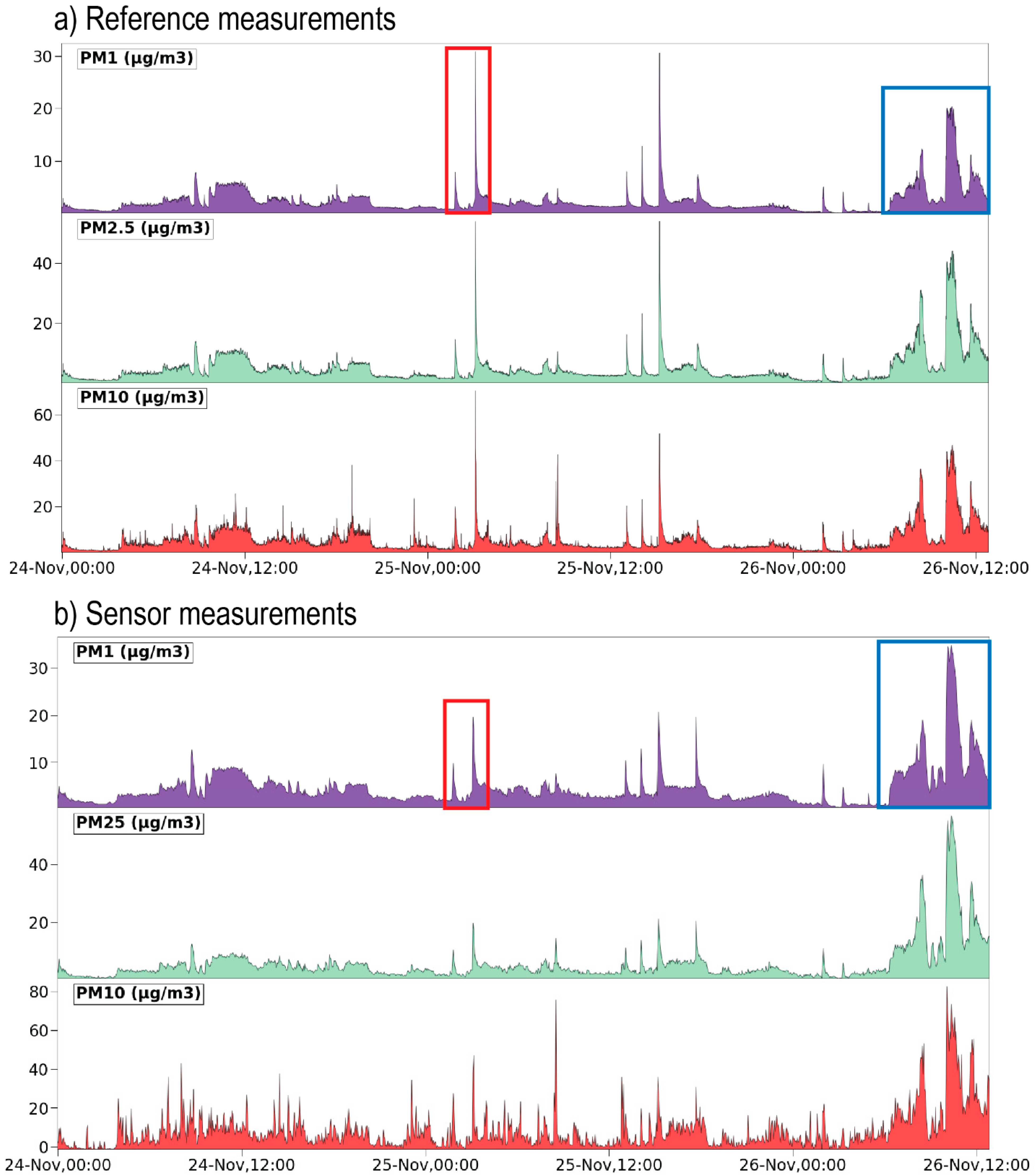
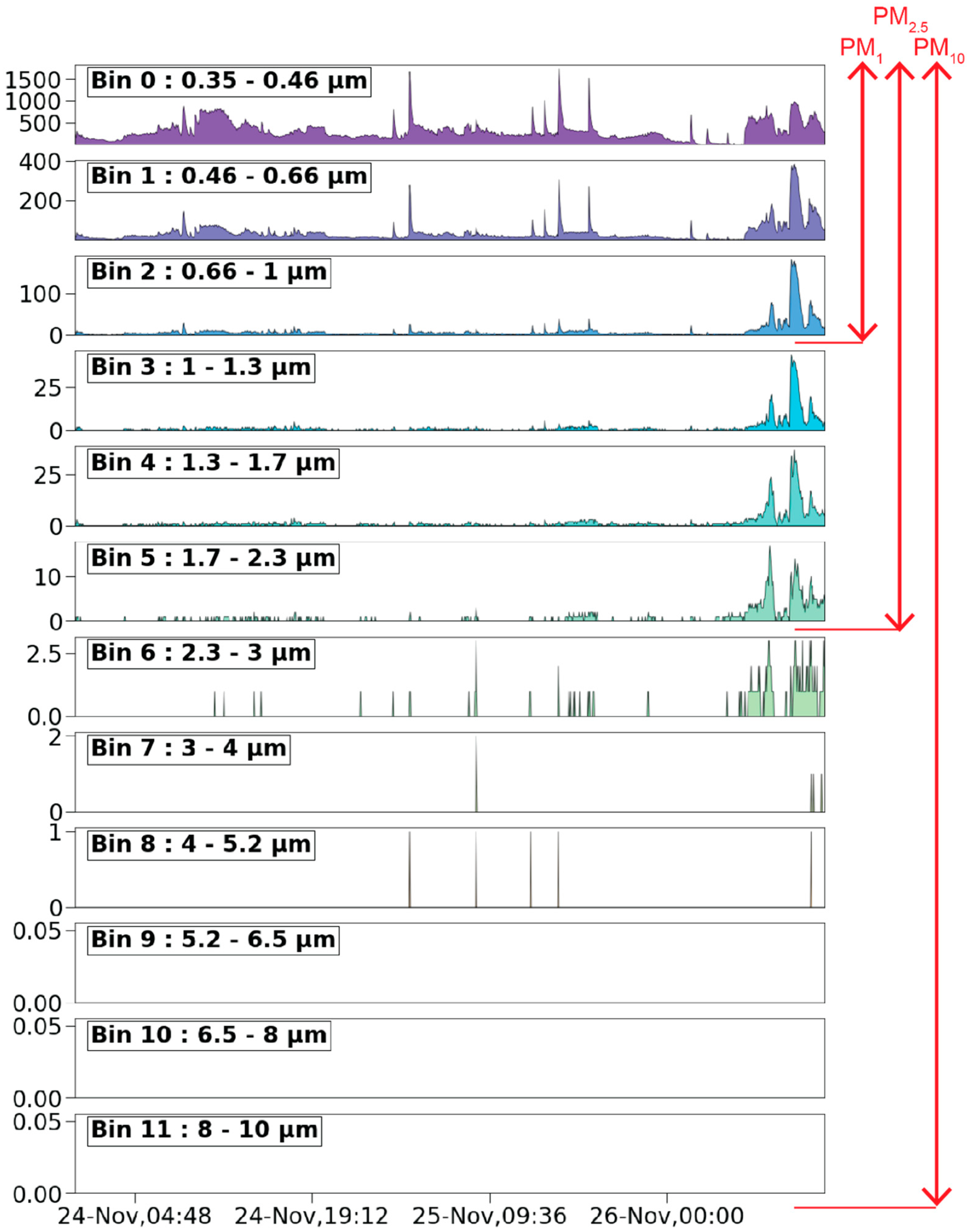
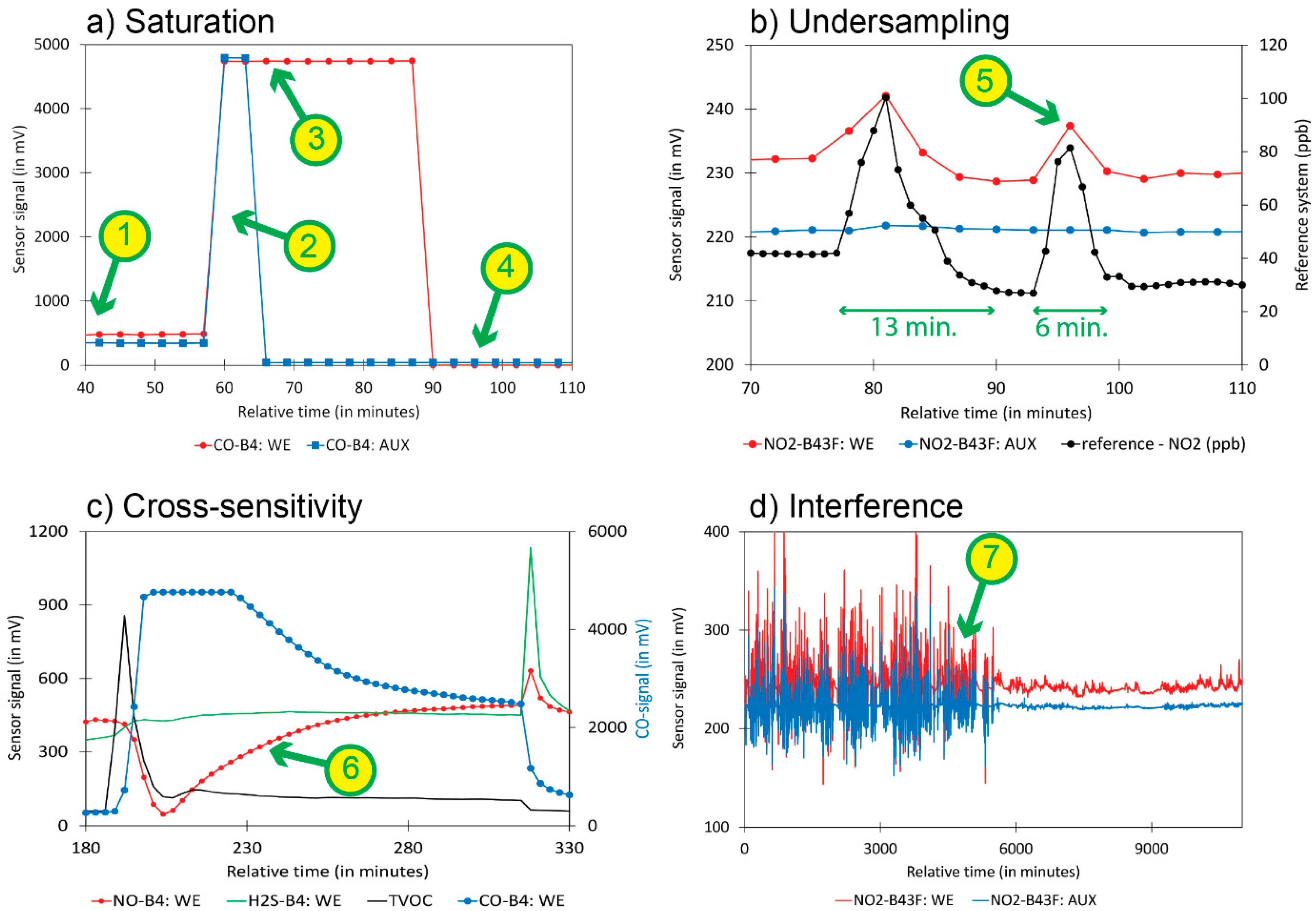
Publisher’s Note: MDPI stays neutral with regard to jurisdictional claims in published maps and institutional affiliations. |
© 2022 by the authors. Licensee MDPI, Basel, Switzerland. This article is an open access article distributed under the terms and conditions of the Creative Commons Attribution (CC BY) license (https://creativecommons.org/licenses/by/4.0/).
Share and Cite
Schalm, O.; Carro, G.; Lazarov, B.; Jacobs, W.; Stranger, M. Reliability of Lower-Cost Sensors in the Analysis of Indoor Air Quality on Board Ships. Atmosphere 2022, 13, 1579. https://doi.org/10.3390/atmos13101579
Schalm O, Carro G, Lazarov B, Jacobs W, Stranger M. Reliability of Lower-Cost Sensors in the Analysis of Indoor Air Quality on Board Ships. Atmosphere. 2022; 13(10):1579. https://doi.org/10.3390/atmos13101579
Chicago/Turabian StyleSchalm, Olivier, Gustavo Carro, Borislav Lazarov, Werner Jacobs, and Marianne Stranger. 2022. "Reliability of Lower-Cost Sensors in the Analysis of Indoor Air Quality on Board Ships" Atmosphere 13, no. 10: 1579. https://doi.org/10.3390/atmos13101579
APA StyleSchalm, O., Carro, G., Lazarov, B., Jacobs, W., & Stranger, M. (2022). Reliability of Lower-Cost Sensors in the Analysis of Indoor Air Quality on Board Ships. Atmosphere, 13(10), 1579. https://doi.org/10.3390/atmos13101579






